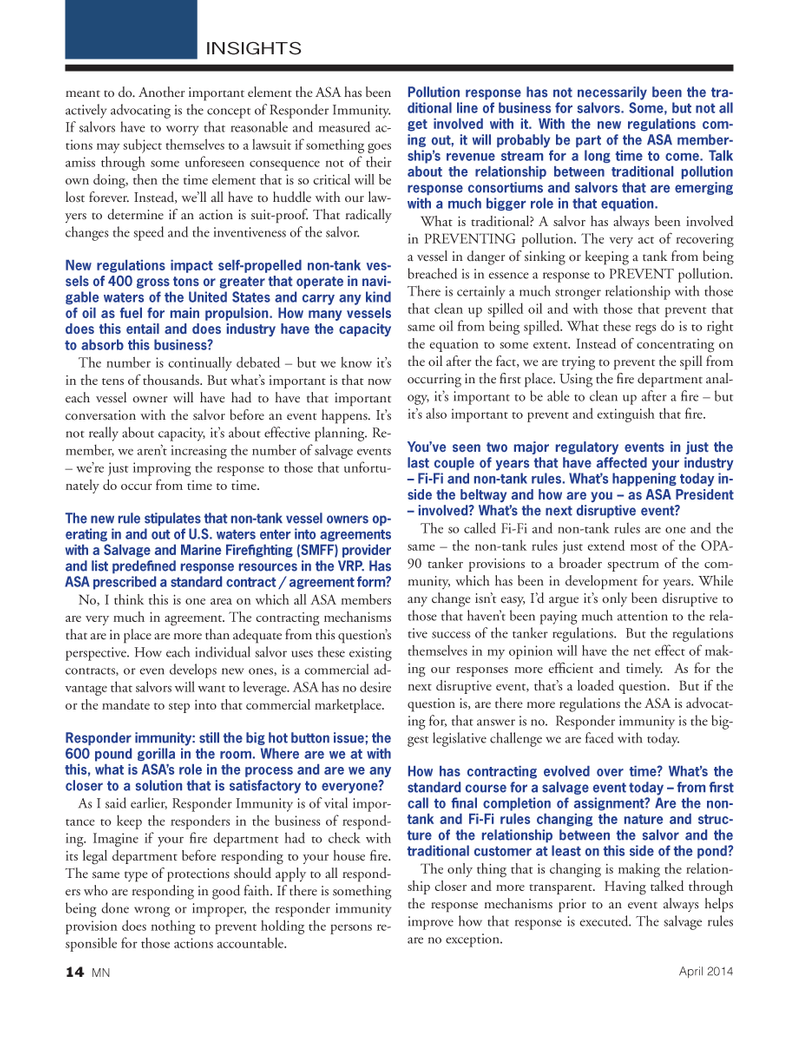
Page 14: of Marine News Magazine (April 2014)
Shipyard Report: Construction & Repair
Read this page in Pdf, Flash or Html5 edition of April 2014 Marine News Magazine
meant to do. Another important element the ASA has been actively advocating is the concept of Responder Immunity. If salvors have to worry that reasonable and measured ac- tions may subject themselves to a lawsuit if something goes amiss through some unforeseen consequence not of their own doing, then the time element that is so critical will be lost forever. Instead, we?ll all have to huddle with our law- yers to determine if an action is suit-proof. That radically changes the speed and the inventiveness of the salvor. New regulations impact self-propelled non-tank ves- sels of 400 gross tons or greater that operate in navi- gable waters of the United States and carry any kind of oil as fuel for main propulsion. How many vessels does this entail and does industry have the capacity to absorb this business?The number is continually debated ? but we know it?s in the tens of thousands. But what?s important is that now each vessel owner will have had to have that important conversation with the salvor before an event happens. It?s not really about capacity, it?s about effective planning. Re- member, we aren?t increasing the number of salvage events ? we?re just improving the response to those that unfortu- nately do occur from time to time. The new rule stipulates that non-tank vessel owners op-erating in and out of U.S. waters enter into agreements with a Salvage and Marine FireÞ ghting (SMFF) provider and list predeÞ ned response resources in the VRP. Has ASA prescribed a standard contract / agreement form? No, I think this is one area on which all ASA members are very much in agreement. The contracting mechanisms that are in place are more than adequate from this question?s perspective. How each individual salvor uses these existing contracts, or even develops new ones, is a commercial ad- vantage that salvors will want to leverage. ASA has no desire or the mandate to step into that commercial marketplace. Responder immunity: still the big hot button issue; the 600 pound gorilla in the room. Where are we at with this, what is ASAÕs role in the process and are we any closer to a solution that is satisfactory to everyone?As I said earlier, Responder Immunity is of vital impor- tance to keep the responders in the business of respond- ing. Imagine if your re department had to check with its legal department before responding to your house re. The same type of protections should apply to all respond- ers who are responding in good faith. If there is something being done wrong or improper, the responder immunity provision does nothing to prevent holding the persons re- sponsible for those actions accountable. Pollution response has not necessarily been the tra- ditional line of business for salvors. Some, but not all get involved with it. With the new regulations com- ing out, it will probably be part of the ASA member- shipÕs revenue stream for a long time to come. Talk about the relationship between traditional pollution response consortiums and salvors that are emerging with a much bigger role in that equation. What is traditional? A salvor has always been involved in PREVENTING pollution. The very act of recovering a vessel in danger of sinking or keeping a tank from being breached is in essence a response to PREVENT pollution. There is certainly a much stronger relationship with those that clean up spilled oil and with those that prevent that same oil from being spilled. What these regs do is to right the equation to some extent. Instead of concentrating on the oil after the fact, we are trying to prevent the spill from occurring in the rst place. Using the re department anal- ogy, it?s important to be able to clean up after a re ? but it?s also important to prevent and extinguish that re. YouÕve seen two major regulatory events in just the last couple of years that have affected your industry Ð Fi-Fi and non-tank rules. WhatÕs happening today in- side the beltway and how are you Ð as ASA President Ð involved? WhatÕs the next disruptive event? The so called Fi-Fi and non-tank rules are one and the same ? the non-tank rules just extend most of the OPA- 90 tanker provisions to a broader spectrum of the com- munity, which has been in development for years. While any change isn?t easy, I?d argue it?s only been disruptive to those that haven?t been paying much attention to the rela- tive success of the tanker regulations. But the regulations themselves in my opinion will have the net effect of mak- ing our responses more ef cient and timely. As for the next disruptive event, that?s a loaded question. But if the question is, are there more regulations the ASA is advocat- ing for, that answer is no. Responder immunity is the big- gest legislative challenge we are faced with today. How has contracting evolved over time? WhatÕs the standard course for a salvage event today Ð from Þ rst call to Þ nal completion of assignment? Are the non- tank and Fi-Fi rules changing the nature and struc- ture of the relationship between the salvor and the traditional customer at least on this side of the pond?The only thing that is changing is making the relation- ship closer and more transparent. Having talked through the response mechanisms prior to an event always helps improve how that response is executed. The salvage rules are no exception. INSIGHTS14 MNApril 2014MN April14 Layout 1-17.indd 14MN April14 Layout 1-17.indd 143/20/2014 11:35:58 AM3/20/2014 11:35:58 AM

 13
13

 15
15
